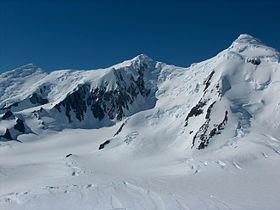Tangra Mountains
| Tangra Mountains | |
|---|---|

Central Tangra Mountains
|
|
| Highest point | |
| Peak | Mount Friesland |
| Elevation | 1,700 m (5,600 ft) |
| Dimensions | |
| Length | 30 km (19 mi) |
| Width | 8 km (5.0 mi) |
| Geography | |
| Continent | Antarctica |
| State/Province | South Shetland Islands |
| Range coordinates | 62°40′00″S 60°06′00″W / 62.6667°S 60.1°WCoordinates: 62°40′00″S 60°06′00″W / 62.6667°S 60.1°W |
Tangra Mountains (in Bulgarian Тангра планина, 'Tangra planina' \'tan-gra pla-ni-'na\) (62°40′00″S 60°06′00″W / 62.66667°S 60.10000°W) form the principal mountain range of Livingston Island in the South Shetland Islands, Antarctica. The range had been nameless until 2001, when it was named after the Bulgar god Tangra.
Tangra Mountains are 30 km long between Barnard Point and Renier Point, 8 km wide, and are bounded by Moon Bay and Huron Glacier to the north, Huntress Glacier to the northwest, False Bay to the west, and Bransfield Strait to the southeast, and is linked to Bowles Ridge by Wörner Gap, and to Pliska Ridge by Nesebar Gap. The mountain is divided in three principal ridges: Friesland Ridge in the west, Levski Ridge in the centre, and Delchev Ridge in the east.
The peaks and slopes of Tangra are heavily glaciated, and drained by the glaciers Huron, Huntress, Ruen Icefall, Peshtera, Charity, Tarnovo Ice Piedmont, Prespa, Macy, Boyana, Srebarna, Magura, Dobrudzha, Ropotamo, Strandzha, Pautalia, Sopot Ice Piedmont, and Iskar.
...
Wikipedia

